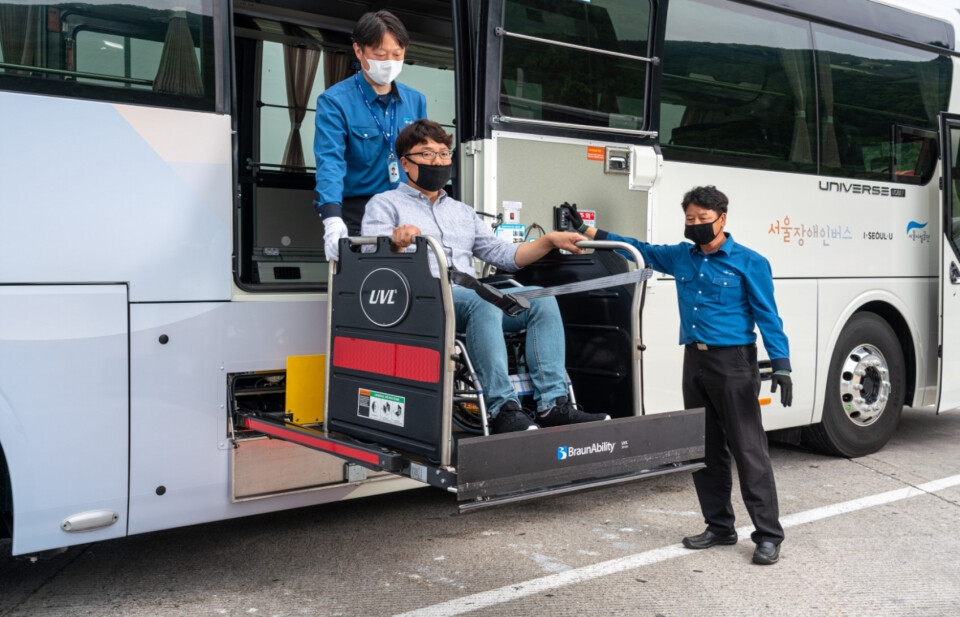
For individuals with disabilities, ensuring mobility rights extends beyond mere physical movement; it is a fundamental right to enjoy daily life as equal citizens, with access to education, employment, and social services. While legal frameworks for these basic rights are in place, the reality is often a stark contrast, with public transportation falling short in practically guaranteeing these mobility rights.
In response to this pressing issue, the National Assembly Library recently published a report titled "Latest Foreign Policy Information Report on Public Transportation Mobility Support Policies for People with Disabilities in the United States and the United Kingdom." This report shares valuable case studies on how these two nations are addressing and striving to improve public transportation accessibility for their disabled populations.
The United States: 99.9% of Buses and 92% of Light Rail Vehicles Are Accessible
The United States has made significant strides in ensuring public transportation accessibility, largely driven by the Americans with Disabilities Act (ADA), enacted in 1990 and fully implemented from 1992. This landmark legislation prohibits discrimination against individuals with disabilities and mandates their support. Crucially, the ADA stipulates that public transportation services must not discriminate against people with disabilities and must ensure their accessibility. This legal mandate has been instrumental in the widespread adoption of low-floor buses.
The U.S. Federal Regulations, specifically the "Transportation Services for Individuals with Disabilities" regulations established by the Secretary of Transportation, further impose phased obligations on transportation providers to ensure accessibility on long-distance buses.
According to the American Public Transportation Association's (APTA) annual Fact Book, accessibility for public transportation modes in the U.S. has vastly improved for individuals using wheelchairs and those with other disabilities affecting travel. Data from the 2023 Fact Book, comparing trends from 2003 to 2023, showcases this progress:
The percentage of accessible buses increased from 93% in 2003 to an impressive 99.9% in 2023. This near-universal accessibility for buses highlights a significant commitment to inclusive transit.
Commuter railcar accessibility saw an increase from 68% to 82%. While not as high as buses, this still represents substantial progress in making rail travel more inclusive.
Light rail vehicle accessibility improved from 82% to 92%.
Trolley (trackless trolley) vehicle accessibility reached 100% from 70%, indicating complete accessibility for this mode of transport.
Beyond general public transit, various transportation operators across different regions in the U.S. offer diverse forms of complementary paratransit services. A prime example is New York City's Access-A-Ride (AAR) program. AAR provides transportation for individuals with disabilities who are unable to use fixed-route public transportation like buses or subways due to accessibility issues. This service transports riders to their destinations or to public transportation stations that are accessible to people with disabilities.
Access-A-Ride operates across New York City's five boroughs and some adjacent areas near the city's boundaries. It maintains the same fare as regular public transportation and operates 24 hours a day, seven days a week. AAR is a shared-ride program, meaning passengers may travel with others. Reservations typically need to be made one to seven days in advance, either by phone or online. For visually impaired passengers, the service even provides an audible announcement from the driver upon the vehicle's arrival, further enhancing accessibility and safety. The continuous investment in accessible infrastructure and services, as exemplified by the introduction of electric paratransit vehicles into the AAR fleet in 2024, demonstrates an ongoing commitment to modernizing and improving accessible transit options.
The United Kingdom: 99.5% of Vehicles Are Disability Access Certified, With Good Accessibility for Black Cabs and Ride-Sharing Services
The United Kingdom has also been a leader in advancing mobility rights for individuals with disabilities and other transport-disadvantaged groups, primarily under the framework of the Equality Act 2010. This comprehensive legislation legally protects individuals from discrimination in the wider society. Building on earlier efforts, the UK implemented the Disability Discrimination Act (DDA) 2005, which mandated that new long-distance buses be easily accessible for individuals with sensory disabilities and wheelchair users.
The adoption of low-floor buses, first introduced in the mid-1990s, significantly increased from 52% in 2005 to 88% in 2012. More recently, the focus has shifted from merely low-floor buses to the introduction of new vehicles that have received disability access certification, which guarantees a higher level of accessibility. This shift reflects a move towards more comprehensive accessibility standards. The rate of introduction for disability-access certified vehicles dramatically rose from a mere 30.7% in 2005 to an impressive 99.5% in 2024, indicating near-complete accessibility for new vehicles entering service.
Beyond standard bus services, licensed taxis in major urban centers across the UK are generally mandated to be accessible for wheelchair users. Furthermore, individuals with conditions such as epilepsy or hearing impairments are permitted to travel with assistance dogs in taxis.
A notable example is London's iconic Black Cabs (London Taxis) and Private Hire Vehicles (PHVs), which are legally required under Section 165 of the Equality Act 2010 to be fitted with equipment enabling wheelchair user access. Both London Taxis and PHV services must demonstrate their wheelchair accessibility when applying for their operating licenses, ensuring that accessibility is a prerequisite for service provision. This legal obligation has made London's taxi fleet one of the most accessible in the world, often featuring ramps or lifts and ample space for wheelchairs.
In addition to direct transport services, the UK also supports the Motability Scheme, a unique program run in partnership between the UK government and various non-profit organizations. This scheme assists individuals with disabilities and their families or caregivers by providing financial support for the lease of cars, scooters, or powered wheelchairs. Beneficiaries of government-provided disability allowances can utilize a portion of their allowance towards vehicle leasing and adaptation costs. A significant benefit of this scheme is that users can receive a new vehicle every three years, ensuring they always have access to modern and well-maintained accessible transportation. This comprehensive approach, combining legislative mandates with practical support schemes, demonstrates the UK's commitment to ensuring mobility rights for its disabled population.
[Copyright (c) Global Economic Times. All Rights Reserved.]






























